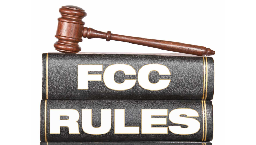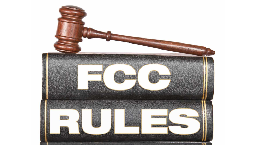Luke Wood has really impressed me over the past year. From the Capradio financial issues to how he addressed the current protest to this latest policy change. He's one of the best presidents CSUS has had in my memory.
I'm also glad the students were able to affect some change. Let's hope successes like this spread.
Poor Thomas.
Baud rate replaced by bandwidth limit
The Federal Communications Commission has removed certain restrictions on ham radio operators, acting on a request that the ARRL made a decade ago.

cross-posted from: https://lemm.ee/post/14953208
> Bands with a 300 baud rate limitation eliminated by this order are the 160 meter band; 80 meter band; 40 meter band segments 7.000–7.100 MHz and 7.100–7.125 MHz; 30 meter band; 20 meter band segment 14.00–14.15 MHz; 17 meter band segment 18.068–18.110 MHz; 15 meter band segment 21.0–21.2 MHz; and 12 meter band segment 24.89–24.93 MHz. The 10 meter band segment 28.0–28.3 MHz has a 1200 baud rate limitation, which is also lifted. > > “Instead, the commission establishes a 2.8 kHz bandwidth limitation in the applicable amateur radio bands,” it said.
Baud rate replaced by bandwidth limit
The Federal Communications Commission has removed certain restrictions on ham radio operators, acting on a request that the ARRL made a decade ago.

Bands with a 300 baud rate limitation eliminated by this order are the 160 meter band; 80 meter band; 40 meter band segments 7.000–7.100 MHz and 7.100–7.125 MHz; 30 meter band; 20 meter band segment 14.00–14.15 MHz; 17 meter band segment 18.068–18.110 MHz; 15 meter band segment 21.0–21.2 MHz; and 12 meter band segment 24.89–24.93 MHz. The 10 meter band segment 28.0–28.3 MHz has a 1200 baud rate limitation, which is also lifted.
“Instead, the commission establishes a 2.8 kHz bandwidth limitation in the applicable amateur radio bands,” it said.
Thank you very much for taking the time to respond and explain a bit more to connect the dots for me. I didn't notice the built-in @AMRRON group name nestled in the rest of the special purpose groups. I definitely don't appreciate their inclusion, since it is tacit approval of the group, as you alluded to.
Yeah, the FCC document definitely made the potential to leave relaying enabled iffy. I really wish I was a better coder, or I'd fork the code, remove the @AMRRON group and pop up a prompt of whether to allow a relayed message, or only allow to/from trusted parties.
Can you spell it out a bit? I read through the linked sources (that I had access to) and couldn't determine a clear link between the software's developer and J6/OathKeepers/Redoubt movement other than the mode is used by those fringe elements. The "Supports" link is just to the JS8 user manual and the other links don't have clear ties to Jordan or JS8. Admittedly, I'm not a member of the js8call groups.io group, so I wasn't able to read through that source to see if a tie was more clearly established.
I'm all for not supporting those who are trying move the US to christofascism, but avoiding the most popular free-form digital chat mode because of an alleged link is a stretch. It would be nice to have an "allow list" for who you're willing to accept messages for, or allowed recipients, but to me, the protocol is still plenty useful without having message forwarding enabled.
Thank you very much!
Check out pskreporter.info for some live maps of propagation as well. Welcome to the HF digital party!
I've got an inverted V fan dipole on my roof that's tuned for 20/40, with the peak maybe 25 feet up. It works just fine, even though there's quite a bit of QRM in my neighborhood. The noise floor is S7-S9 across most bands.
I had solely been using a QRP labs QDX (fun kit btw!) and had quite a bit of success within the US, with contacts as far as FL from my QTH in CA. I recently got a FT-897 and have been enjoying the extra power. Had a nice QSO to Argentina (FF92) the other night using JS8 with 25W from CM98. I still leave the QDX on during the day when I'm working to keep an eye on the bands; I feel better about the idea of burning it out than I do a more expensive radio.
I spend much more time on JS8 than FT8, just because it's human interaction instead of computer to computer. FT8 is a great way to get a lot more contacts from a larger number of stations and locations though.
without ever seeing combat
Tell that to the unarmed balloons shot down earlier this year!
Capradio Cuts Staff and Ends Shows Amid Budget Issues
Capradio laid off 12% of their staff, and ended some of its weekend music shows, including Mick Martin’s Blues Party, Hey Listen with Nick Bruner, At the Opera, and K-ZAP on CapRadio.
Additional context with a bonus quote from Nick Brunner - "Now that dries up immediately thanks to this incredibly poorly thought out, reprehensible action on behalf of Tom Karlo and the CapRadio board."
Agreed about wishing it would be open source. The most usable OSS combo I've found for using my rspdx over a network is SoapySDR and CubicSDR and CubicSDR hasn't had a release since Feb 2022.
I'm forcing myself to remember that this is just essentially a beta release, with a lot of features missing. With as long as it took them to release this version, I'm not holding my breath to get new features any time soon though.
Looks like it says "The Beverly Estate". I really like the "Cocaine toothache drop" backrest on the pool bench, stay classy 1%!
SDRconnect - New Software for SDRPlay Devices
After a long wait, SDRPlay finally released a preview version of SDRconnect, their new cross-platform software for all SDRPlay SDR receivers except the rsp1. This release includes native network streaming, meaning you can set up 2 devices running SDRconnect, 1 in server mode with the SDR plugged in, and the other remotely connected via the network.
Check out https://www.sdrplay.com/sdrconnect/ for more information. I'm not affiliated with SDRPlay in any way, I've just been anxiously waiting for this release for many months.
It's a tensahedron stand that needs a single anchor to support itself. I normally use the hitch on my truck, but have tied to exposed roots, fence posts, door jambs, large rocks, etc...
I'm pretty fond of my portable hammock stand made from extendable paint poles. It's something I leave in the back of my truck, so I can hang anywhere I am. It's nice when camping in places where hanging from trees isn't allowed, or there are no trees at all. It really opens up the opportunities on road trips.
Thanks!
That's what I'm hoping to try this coming weekend. Thankfully the frequency is high enough that it's not difficult to get it a few wavelengths away from anything to remove the chance of interference.
It helped me a lot to remember that every antenna is, at its heart, a dipole. If your radials are above horizontal (less than 90 degrees to the vertical element), then you’re adding capacitance and making it tune high.
This really helped contextualize it for me, thank you.
I haven't had time to get out there and play with the antenna for a few days. I'll hopefully have some time this coming weekend to play with shortening the radials and seeing about getting a more optimal antenna.
I saw a story in the Bee the other day that Fixins Soul Kitchen was top rated on Yelp. Haven't been, and the fact that it's owned by Kevin Johnson gives me pause at going, but it's allegedly rated well.
Ground plane antennas - radial angle and length
I recently built myself a ground plane ADSB antenna. Following the results of an online calculator got me in the ballpark of the lowest SWR being close to my target frequency. At this point, I started adjusting things and noticed that the SWR shifted when I adjusted the vertical angle of the radials. SWR shifted to my chosen frequency when the radials were about 20* above the horizon, which looks like no ground plane antenna I've ever seen before, which either have horizontal or radials angled down at 45*.
With that background, I have 3 questions: 1: What is the implication on radiation/reception pattern of ground plane radials above horizontal? Am I missing out on transmissions close to the horizon and adding vertical gain?
2: Does SWR being lowest with "inverted" radials indicate that the radials are too long? Too short? Just right and I did something else wrong?
3: Is ground plane radial length measured from the attachment point, or the theoretical distance between the end of the radial and the bottom of the radiator? There's a good chance I built these too long, since I measured the radial length from the attachment point, not the base of the radiator (~1cm further)
Thanks for any guidance! Antennas are black magic to me, and I clearly don't know the right terms to put into search engines to find the results to these questions.
Im expecting a “We didn’t start the fire” 2025 edition
Fallout boy released their own updated version 4 days ago. Just like everything else, it doesn't even come close to measuring up to the past.